|
|
|
|
|
Oil On
Canvas, Real Flavor of Old Masters
|
|

|
ARTWORKS
INDEX
A B C D E F G H I J K L M N O P Q R S T U V W X Y Z |
ARTISTS
INDEX
A B C D E F G H I J K L M N O P Q R S T U V W X Y Z |
|
|
| | |
|
|
 |
HOOCH, Pieter de -- Click Here
|
|
Dutch Baroque Era Painter, 1629-1684
Dutch painter. He was one of the most accomplished 17th-century Dutch genre painters, excelling in the depiction of highly ordered interiors with domestic themes and merry companies and pioneering the depiction of genre scenes set in a sunlit courtyard. The hallmarks of his art are an unequalled responsiveness to subtle effects of daylight, and views to adjoining spaces, either through a doorway or a window, |
|
 |
Hiram Powers -- Click Here
|
|
American Neoclassical Sculptor, 1805-1873, American sculptor. He grew up in Cincinnati, OH, and his career as a sculptor began when he created animated wax figures for a tableau of Dante's Inferno at Dorfeuille's Western Museum in Cincinnati, where he was supervisor of the mechanical department. He learnt to model clay and make plaster casts from Frederick Eckstein (c. 1775-1852). The portrait busts he created of his friends attracted the attention of the wealthy Nicholas Longworth, who financed trips for Powers to New York in 1829 and to Washington, DC, in 1834, when he sculpted President Andrew Jackson (marble, c. 1835; New York, Met.). Powers's strikingly lifelike bust, classicized only by the drapery, brought him commissions from other Washington luminaries, including John Marshall (marble, 1835; Washington, DC, US Capitol), Martin van Buren (marble, 1837; New York, NY Hist. Soc.) |
|
 |
Hippolyte Petitjean -- Click Here
|
|
Hippolyte Petitjean (1854 - 1929)
|
|
 |
Hindu painter -- Click Here
|
|
Richard Ettinghausen believes this work to have been painted in Agra in about 1625
|
|
 |
Henry William Pickersgill -- Click Here
|
|
English Painter, 1782-1875
was an English painter specialising in portraits. He was a Royal Academician for almost fifty years, and painted many of the most notable figures of his time. Born in London, Pickersgill was adopted in his youth by a Mr Hall, a silk manufacturer in Spitalfields, who financed his schooling and then took him into the family business. However, when war caused difficult trading conditions, Pickersgill opted to develop his talent for painting into a career, and was a pupil of landscape artist George Arnald between 1802 - 1805 before entering the Royal Academy Schools as a student in November 1805.His early subjects were varied and included landscapes and classical and historical themes, but he eventually settled to portraiture as his speciality. His first exhibit at the Royal Academy was a portrait of his benefactor Mr Hall, and during his lifetime he showed a total of 384 paintings there. He was elected to associate membership of the Academy in November 1822 and full membership in February 1826. Pickersgill was one of the pre-eminent portrait painters of his day. William Wordsworth, George Stephenson, Jeremy Bentham, Elizabeth Barrett Browning, Lord Nelson, the Duke of Wellington and Faraday were among the many notable people who sat for him. He famously painted author James Silk Buckingham and his wife Elizabeth in Arab costume in 1816, reflecting Buckingham's own travels in the East as well as the fashion of the times for the Orient. The National Portrait Gallery, London has over 50 of his portraits in its collection, including 16 original oils and 35 engravings after him, along with a small number of portraits of Pickersgill himself by others. From 1856?C64 he was librarian of the Royal Academy. He retired from the institution in December 1872, and died at his home in Blandford Square, London at the age of 93. Pickersgill's brother Richard, son Henry Hall and nephew Frederick Richard were also painters. |
|
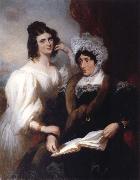 |
Henry Perronet Briggs -- Click Here
|
|
British Painter, ca.1791-1844 |
|
|
|
 |
Henry P.Moore -- Click Here
|
|
American artist 19 century
|
|
|
|
 |
Henry Arthur Payne -- Click Here
|
|
British Architect , 1868-1940 |
|
 |
Henrique Pousao -- Click Here
|
|
Henrique Cear de Arauo Pousa (Vila Vicsa, 1 January 1859 - Vila Vicsa, 20 March 1884) was a Portuguese painter.
|
|
 |
Henri-Pierre Picou -- Click Here
|
|
(27 February 1824 - 17 July 1895) was a French painter born in Nantes.His oeuvre began with portraits and classical historical subject matter but he later moved on to allegorical and mythological themes.He was an academic painter and one of the founders of the Neo-Grec school, along with his close friends Gustave Boulanger, Jean-L??on G??rôme, and Jean-Louis Hamon, also academic painters. All of them studied in the workshops of both Paul Delaroche and later Charles Gleyre. Picou's style was noticeably influenced by Gleyre. While the rest of the group generally painted classical and mythological subjects, Picou also received commissions for large religious frescoes from many churches, including the Église Saint-Roch.
His artistic debut was at the Salon in 1847. The next year he was awarded a second-class medal for his painting, Cl??opâtre et Antoine sur le Cydnus. Also known as Cleopatra on the Cydnus, it is commonly regarded as Picou's masterpiece. This showing at the Salon in 1848 was written about by the critic Th??ophile Gautier, who felt that the subject matter was too ambitious, but also said that "As it is, it gives the best hope for the future of the young artist, and ranks among the seven or eight most important paintings of the Salon.In 1875 the painting was exhibited in New York, and afterward found lodgment on the walls of a private art gallery in San Francisco.Picou maintained a large workshop in Paris on the Boulevard de Magenta, which provided him room to work on his expansive frescoes. His popularity continued to rise and he went on to win the Second Prix de Rome in 1853 for his painting, J??sus chassant les vendeurs du Temple (The Moneylenders Chased from the Temple), and another second-class medal for his Salon painting in 1857. From his debut in 1847, he was a regular at the Salon, showing almost every year until his final exhibit in 1893.He has been called the most fashionable painter towards the close of the Second French Empire |
|
 |
Henri-Pierre Danloux -- Click Here
|
|
(February 24, 1753 - January 3, 1809) was a French painter and draftsman.
He was born in Paris. Brought up by his architect uncle, Danloux was a pupil of Lepicie and later of Vien, whom he followed to Rome in 1775. In 1783, he returned to Lyon and Paris, where he was patroned by the Baronne Megret de Serilly d'Etigny, who secured for him a number of important portrait commissions. He emigrated to London in 1792 during the French Revolution and returned to Paris in 1801. Danloux was influenced by fashionable English portrait painters such as Thomas Lawrence (1769-1830), John Hoppner (1758-1810), and George Romney (1734-1802). In 1793, he exhibited at the Royal Academy in London which resulted in commissions from a number of British patrons. Danloux returned to Paris in 1801, and died there in 1809. |
|
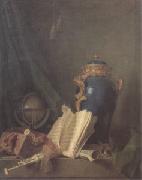 |
Henri-Horace Roland de La Porte -- Click Here
|
|
Paris 1724-1793
French painter. He was a pupil of Jean-Baptiste Oudry and was approved by the Academie Royale de Peinture et de Sculpture in 1761 as a 'painter of animals and fruit'. He presented his morceau de reception, the ambitious Vase of Lapis, Ornamented with Bronze and Placed near a Globe (Paris, Louvre), in 1763. This large painting is reminiscent of Oudry's work and depicts a collection of sumptuous objects against a simple cloth backdrop. Roland de la Porte's later works are much more intimate in scale and approach and depict simple rustic objects in a restrained yet realistic fashion in a manner akin to Chardin, for whose works his own have been mistaken. The Still-life with Bread and Fruit (Rotterdam, Boymans-van Beuningen) is bathed in a warm light; the composition is unusual in that the bread, plums and preserve pot are represented at the viewer's eye level, obscuring the top of the table. The Little Orange Tree (Karlsruhe, Staatl. Ksthalle) uses several devices similar to those used by Chardin: a light source comes from the upper left-hand side, throwing some of the surfaces into relief and highlighting them against the indistinct background; a single straw is brought into focus and seems to protrude out of the picture |
|
 |
Henri Pierre Danloux -- Click Here
|
|
1753-1809 French
French painter and draughtsman. He was orphaned at an early age and was brought up by an uncle who was an architect and contractor. Around 1770 his uncle apprenticed him to Nicolas-Bernard Lpici. He exhibited for the first time in 1771 at the Exposition de la Jeunesse in Paris, where he showed a Drunkard at a Table (untraced). About 1773 he was admitted into the studio of Joseph-Marie Vien, whom he followed to Rome in 1775 on the latter appointment as Director of the Academie de France. Danloux sketchbooks show that he also travelled to Naples, Palermo, Florence and Venice. He was not interested in the monuments of antiquity but concentrated instead on drawing landscapes and, in particular, portraits, among them that of Jacques-Louis David. |
|
 |
Henri Lebasque Prints -- Click Here
|
|
French Painter, 1865-1937
was born in 1865 at Champign?? (Maine-et-Loire). He started his education at the Ecole des Beaux-Arts d??Angers, and moved to Paris in 1886. Here, Lebasque started studying under L??on Bonnat, and assisted Humbert with the decorative murals at the Panth??on. Around this time, Lebasque met Camille Pissarro and Auguste Renoir, who later would have a large impact on his work.
Lebasque's vision was coloured by his contact with younger painters, especially Edouard Vuillard and Pierre Bonnard, founders of the The Nabis' Group and the Intimists who first favoured the calm and quietude of domestic subject matter. From his first acquaintance with Georges Seurat and Paul Signac, Lebasque learnt the significance of a colour theory which stressed the use of complementary colours in shading.
Lebasque was a founding member of the Salon d'Automne in 1903 with his friend Henri Matisse. Two years later a group of artists exhibited there including Georges Rouault, Andr?? Derain, Edouard Vuillard and Henri Matisse while keeping solid links with other artists such as Gustave Rouault, Raoul Dufy, Louis Valtat and especially Henri Manguin, who made him discover the south of France.
His time in South of France would lead to a radical transformation in Lebasque??s paintings, changing his colour palette forever. Other travels included the Vend??e, Normandie and Brittany, although Lebasque would always prefer the small idyllic villages of the South of France.
Lebasque had some commercial success during his lifetime. He worked on the decorations at the theatre of the Champs-Elys??es and of the Transatlantique sealiner.
Lebasque died at Cannet, Alpes Maritimes in 1937.
His work is represented in French museums, notably Angers, Geneva (Petit Palais), Lille (Mus??e des Beaux-Arts), Nantes and Paris (Mus??e d??Orsay) as well as many more around the world. Famed as a painter of 'joy and light', Lebasque is admired for the intimacy of his subject matter and his unique delight in colour and form. |
|
 |
Henri Felix Emmanuel Philippoteaux -- Click Here
|
|
(1815-1884) was a French artist. He was born in Paris, France, studied art at the studio of Leon Cogniet,and first exhibited his work at the Paris Salon of 1833.
One of his most well-known works was a depiction of the Siege of Paris during the Franco-Prussian War, painted in the form of a cyclorama, a type of large panoramic painting on the inside of a cylindrical platform designed to provide a viewer standing in the middle of the cylinder with a view of the painting. Viewers surrounded by the panoramic image are meant to feel as if they are standing in the midst of a historic event or famous place.
Philippoteaux also produced a large number of works chronicling the rise and successes of Napoleon Bonaparte, including a portrait of Napoleon in his regimental uniform and a group of paintings of French victories in the Napoleonic Wars. Philippoteaux was awarded the Legion d'honneur in 1846.
Philippoteaux's son Paul Philippoteaux was also an artist; both were famous for their production of cycloramas. Father and son collaborated on The Defence of the Fort d'Issy in 1871. |
|
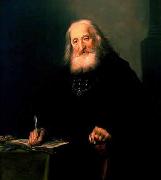 |
Hendrik Gerritsz. Pot -- Click Here
|
|
(c. 1580 - 15 October 1657 (buried)) was a Dutch painter. He lived and painted in Haarlem, where he was an officer of the militia, or schutterij. Dutch artist Frans Hals painted Pot in militia sash in Hals' The Banquet of the Officers of the St George Militia Company (c. 1639). Pot is the man reading a book on the far right.
Pot was born in Amsterdam and spent his early years in Amsterdam and Haarlem. In 1632 he traveled to London, where he painted the Royal Family. He lived from 1633 to 1648 in Haarlem, after which he moved to Amsterdam, where he died in 1657.. He served as Dean of the Haarlem Guild of St. Luke in 1626, 1630 and 1635. He served as the Guild's headman or Hoofdman in 1634 and 1648. He died in Amsterdam. |
|
 |
Helen Frankenthaler Prints -- Click Here
|
|
Born 1928
Helen Frankenthaler (born December 12, 1928) is an American post-painterly abstraction artist. Born in New York City, she was influenced by Jackson Pollock's paintings and by Clement Greenberg. She was the youngest daughter of a justice on the New York State Supreme Court. She studied at the Dalton School under Rufino Tamayo and also at Bennington College in Vermont. She later married fellow artist Robert Motherwell. |
|
 |
Hedouin Pierre -- Click Here
|
|
A fine French painter, etcher and lithographic artist , Boulogne 1820-Paris 1889
|
|
 |
Harriet Powers -- Click Here
|
|
African-American Textile Artist, 1837-1911 |
|
|
|
 |
HALL, Peter Adolf -- Click Here
|
|
1739-1793
Swedish painter and collector. In 1753 he attended Uppsala Universitet to study medicine and natural history. In 1755 he went on a study trip abroad, led by his drawing-master Lars Brisman. While in Germany (1756-9) he studied miniature painting with Eichhardt in Berlin and with Karl Friedrich Wilhelm Richard (1725-70) in Hamburg. After this trip, he decided to become a professional portrait painter, and in 1759 he enrolled at the Kungliga Akademi for de Fria Konsterna in Stockholm, studying drawing with the French sculptor Pierre-Hubert Larchaveque (1721-78) and painting with Gustaf Lundberg. He attracted the attention of C. F. Adelcrantz, who in 1766 gained for him a commission for the pastel portrait of Princes Karl and Fredrik Adolf. In that year he also executed a miniature portrait of Crown Prince Gustav on the occasion of his engagement to Princess Sophia Magdalena of Denmark. Also in 1766 he received a royal travel grant to study in Paris, where he developed a completely new technique of miniature painting using sweeping brushwork and a clear and fresh range of colour that allowed for lively characterization. He made exquisite detailed studies of the backgrounds of his paintings, as well as his sitters costumes and their attributes and accessories. His new technique involved applying gouache to the ivory in a manner that allowed the ivory to show through, a method that was particularly successful in depicting drapery. The smooth surface of the ivory also allowed freer brushwork associated with full-scale portraits. |
|
 |
Gustaf Wilhelm Palm -- Click Here
|
|
Swedish, 1810-1890,Swedish painter. He entered the Royal Academy of Arts in Stockholm in 1828, where he was a student of Carl Johan Fahlcrantz. Following a tour of Norway he went, via Copenhagen, to Berlin and Vienna for three years in order to seek a cure for an eye illness. He was influenced there by Biedermeier painting and Ferdinand Georg Waldm?ller, and also by the architectural painters Jakob Alt (1789-1872) and his son Rudolf Alt. |
|
 |
GREBBER, Pieter de -- Click Here
|
|
Dutch painter, Haarlem school (b. ca. 1600, Haarlem, d. 1652/53, Haarlem)Dutch painter. Together with Salomon de Bray, he was a pioneer among the Haarlem Classicists |
|
 |
Graph paul -- Click Here
|
|
Stockolm,1866
Enkoting 1903
|
|
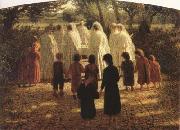 |
Giuseppe Pellizza da Volpedo -- Click Here
|
|
Italian, 1868-1907
was an Italian painter. He was born and died in Volpedo, in the Piedmont region of northern Italy. Pellizza, considered a neo-impressionist artist, was a divisionist painter - using small dots of paints according to specific color theory. His most famous work is Il Quarto Stato ("The Fourth estate"). This rich, expressive work has become a well-known symbol for progressive and socialist causes in Italy, and through out Europe. |
|
 |
Giuseppe Pelizza -- Click Here
|
|
painted Prato fiorito in 1900 - 1903
|
|
 |
Giuseppe Passeri -- Click Here
|
|
Giuseppe Passeri
Giuseppe Passeri (12 March 1654 - 2 November 1714) was an Italian painter of the Baroque period, active in his native city of Rome.
Born the nephew of the painter Giovanni Battista Passeri, Giuseppe trained in the studio of Carlo Maratta. Among the paintings by Giuseppe is St. Peter baptizes the Centurion, transferred to mosaic; the original was moved to a church of the Conventuali in Urbino.
|
|
 |
Giuseppe Antonio Petrini -- Click Here
|
|
(October 23, 1677- c. 1755-9) was a painter of the late-Baroque, active mainly in Lugano, present-day Switzerland.
St. Andrew
City Museum of Rimini, ItalyWhile born in Carona in Canton Ticino and died in Lugano, both in Switzerland, Petrini belongs to the Northern Italian or Lombard heritage of baroque painting. He possibly apprenticed with Bartolomeo Guidobono after 1700. While some works can be found in Como and Bergamo, most are located in Lugano and the surrounding area. He is also listed between 1711 and 1753 as fabbriciere of the church of Madonna deOnegro in Carona. He often painted "portraits" of historical figures including saints, philosophers, and scientists for patrons. One of his more prominent examples is his depiction of an auster St. Peter emerging from the shadows to pinpoint some lines in the gospel. He painted another St. Peter for the parish church of Dubino. Pietro Ligari classified him among the speculative painters, since these portraits, by nature, were imagined.
|
|
 |
Giulio Cesare Procaccini -- Click Here
|
|
1574-1625 Italian Giulio Cesare Procaccini Gallery
Giulio Cesare Procaccini (1574-1625) was an Italian painter and sculptor of the early Baroque era in Milan.
Born in Bologna he was son of the Mannerist painter Ercole Procaccini the Elder and brother of Camillo Procaccini and Carlo Antonio Procaccini. The family moved to Milan around 1585 with the help of the rich art collector Pirro Visconti.
He began as a sculptor in the Cathedral and in the Milanese church of Santa Maria presso San Celso. In 1610 he painted six of the Quadroni, large canvases celebrating Saint Charles Borromeo .
Among his many altarpieces are the Circumcision now in Galleria Estense, Modena (c.1616) and the Last Supper (1616) for Convent associated with the Basilica della Santissima Annunziata del Vastato in Genoa. He also painted the Scourging of Christ.
He worked with Giovanni Battista Crespi (il Cerano) and Pier Francesco Mazzucchelli (il Morazzone) following the directions of Cardinal Federico Borromeo, patron of the arts and cousin of Charles Borromeo. He also painted small religious canvases for rich families, in Milan and in Genoa, where he saw the works of Rubens.
His style shows the influence of Bolognese Mannerism and Venetian colorism and marks the beginning of the Baroque. |
|
 |
Girolamo Parmigianino -- Click Here
|
|
1503-1540 Italian Girolamo Parmigianino Galleries |
|
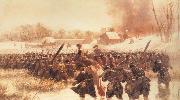 |
Giovanni Ponticelli -- Click Here
|
|
Italian, 1855-1877 |
|
 |
Giovanni Paolo Pannini -- Click Here
|
|
1691-1765
Italian
Giovanni Paolo Pannini Galleries
Italian painter. After gaining fame for his fresco painting, he specialized in Roman topography and became the foremost artist in that field in the 18th century. His real and imaginary views of ancient Roman ruins embody precise observation and tender nostalgia and combine elements of late classical Baroque art with incipient Romanticism. His work was popular both with tourists and his peers: he was admitted to the Acad??mie Française in 1732 and became its professor of perspective. |
|
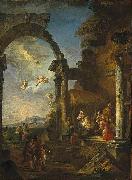 |
Giovanni Paolo Panini -- Click Here
|
|
17 June 1691 - 21 October 1765) was an Italian painter and architect, mainly known as one of the vedutisti .
As a young man, Panini trained in his native town of Piacenza, under Giuseppe Natali and Andrea Galluzzi, and later the stage designer Francesco Galli-Bibiena. In 1711, he moved to Rome, where he studied drawing with Benedetto Luti and became famous as a decorator of palaces, including the Villa Patrizi (1719-1725), the Palazzo de Carolis (1720), and the Seminario Romano (1721-1722). In 1719, Panini was admitted to the Congregazione dei Virtuosi al Pantheon. He taught in Rome at the Accademia di San Luca and the Academie de France, where he influenced Jean-Honore Fragonard. In 1754, he served as the principal of the Accademia di San Luca. Panini died in Rome on 21 October 1765
As a painter, Panini is best known for his vistas of Rome, in which he took a particular interest in the city's antiquities. Among his most famous works are the interior of the Pantheon, and his vedute paintings of picture galleries containing views of Rome. Most of his works, specially those of ruins have a substantial fanciful and unreal embellishment characteristic of capriccio themes. |
|
 |
Giovanni Paolo Lomazzo -- Click Here
|
|
1538 - 1600
was an Italian painter, belonging to the second generation that produced Mannerism in Italian art and architecture. Gian Paolo Lomazzo was born in Milan from a family emigrated from the town of Lomazzo. His early training was with Giovan Battista della Cerva in Milan. He painted a large Allegory of the Lenten Feast for San Agostino in Piacenza (1567). He also painted an elaborate dome with Glory of Angels for the Capella Foppa in San Marco in Milan. He also painted the Fall of Simon Magus in the wall of the chapel. Lomazzo became blind in 1571, and turning to writing, produced two complex treatises that are milestones in the development of art criticism. His first work, Trattato dell'arte della pittura, scoltura et architettura (1584) is in part a guide to contemporary concepts of decorum, which the Renaissance inherited in part from Antiquity, which controlled a consonance between the functions of interiors and the kinds of painted and sculpted decors that would be suitable; Lespingola offered a systematic codification of esthetics that typifies the increasingly formalized and academic approaches typical of the later sixteenth century. His less practical and more metaphysical Idea del tempio della pittura ("The ideal temple of painting", 1590) offers a description along the lines of the "four temperaments" theory of the human nature and personality, |
|
 |
Giovanni di Pietro called lo Spagna -- Click Here
|
|
ca 1450-Spoleto 1528 |
|
 |
Giovanni di Paolo -- Click Here
|
|
Italian Early Renaissance Painter, ca.1403-1483,major Italian painter of the Sienese school. Typical of the Sienese painters of his era, he paid scant attention to the artistic innovations made in nearby Florence, but often depended on the style established by the Sienese masters of the 14th cent. Fortunately, Giovanni di Paolo was endowed with great imagination. His first dated work (1426) was the Pecci altarpiece (major panels in Siena; predella panels in the Walters Art Gall., Baltimore). He produced a tremendous number of works during his long career. Many paintings have remained in Siena, but there are probably more examples of his art in the United States. The Metropolitan Museum has several of his paintings; among them is a delightful scene of Paradise; in the Philip Lehman collection is the exquisite Creation of the World. The Madonna and Child in a Landscape (Mus. of Fine Arts, Boston) exemplifies his inclination toward pure fantasy and disregard for the laws of perspective. Giovanni di Paolo is best represented by six highly expressive scenes from the life of St. John the Baptist (Art Inst., Chicago). |
|
 |
Giovanni dal ponte -- Click Here
|
|
Italian Painter, 1385-1437
He was reputed to have been a student of Spinello Aretino. He acquired the name dal Ponte due to the location of his studio at Santo Stefano a Ponte, Florence. He joined the Arte dei Medici e degli Speziali in 1410 and the Compagnia di S Luca in 1413. Outstanding debts brought him a prison sentence in 1424, but he still owed money to a carpenter three years later. By the late 1420s he had opened his own studio and formed a partnership with the painter Smeraldo di Giovanni (c. 1365-after 1442). Giovanni dal Ponte's varied and prolific production, which continued until his death, included fresco cycles, panels and the decoration of small objects. A number of allegorical panel paintings and cassoni are attributed to him. The animated, stylized figures in the Seven Liberal Arts (1435; Madrid, Prado) are shown in a garden dotted with naturalistic flowers and plants. His early work shows the impact of the Late Gothic style. |
|
 |
Giovanni Battista Pittoni -- Click Here
|
|
Giambattista Pittoni (June 6, 1687-November 6, 1767) was an Italian painter of the late-Baroque or Rococo period, active mainly in his native Venice.
Pittoni was born in Venice, and studied painting under his uncle Francesco Pittoni and Antonio Balestra. Little is known of his early career. He entered the Venetian painters' guild in 1716. In 1722-1723, he was commissioned to paint eThe Torture of St Thomase for San Stae in Venice, which also contains one if his later works in its sacristy. He also completed the transit of Santa Maria in Organo in Verona in 1725. In 1727, he was appointed honorary Academician of the Accademia Clementina in Bologna. In subsequent years, Pittoni never left his native Venice, but completed a number of important and lucrative commissions from German, Polish, Russian, Italian and Austrian patrons, including eThe Sacrifice of Jephthah's daughtere for the Royal Palace of Turin, a number of works for the Marshal von Schulenburg, and a eMartyrdom of St Batholomewe for the Basilica of Saint Anthony of Padua. Pittoni came to be known for his "grand-manner" canvases depicting religious, historical, and mythological subjects (such as Sophonisba and Polyxena).
By 1740, he established a studio and residence in the San Giacomo district of Venice, and took on numerous apprentices. Pittoni died at age 80 on November 6, 1767. His tomb is at the church of San Giacomo dall'Orio in Venice.
Pittoni was a co-founder of the official painter's academy in Venice (in competition to the old fraglia or painter's guild), the Accademia di Belle Arti di Venezia, and he succeeded as President (1758-1761) his contemporary Giovanni Battista Tiepolo. His mature palette was noted, as was Tiepolo's, for his lightness of tone. Besides Tiepolo, Pittoni's influences were Giovanni Battista Piazzetta, Sebastiano Ricci, and Antonio Balestra. His paintings were of a Rococo style, but later became more sedate in their approach towards Neoclassicism. |
|
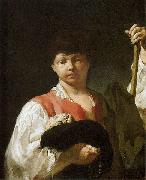 |
Giovanni Battista Piazzetta -- Click Here
|
|
(also called Giambattista Piazzetta or Giambattista Valentino Piazzetta) (February 13, 1682 or 1683 ?C April 28, 1754) was an Italian rococo painter of religious subjects and genre scenes.
Piazzetta was born in Venice, the son of a sculptor Giacomo Piazzetta, from whom he had early training in wood carving. Starting in 1697 he studied with the painter Antonio Molinari. By Piazzetta's account, he studied under Giuseppe Maria Crespi while living in Bologna in 1703-05, although there is no record by Crespi of formal tutelage. Piazzetta did find inspiration in Crespi's art, in which the chiaroscuro of Caravaggio was transformed into an idiom of graceful charm. He was also greatly impressed by the altarpieces created by another Bolognese painter of a half-century earlier, Guercino.
Around 1710, he returned to Venice. There he won recognition as a leading artist despite his limited output and his unassuming nature, but he ultimately was less patronized, both in Venice and especially abroad, than two other eminent stars in Venetian late-Baroque/Rococo, Ricci and Tiepolo. These two painters had a luminous palette and facile ease that allowed them to carpet meters of ceiling with frescoes, although with a superficiality and glamor that is absent from Piazzetta's darker and more intimate depictions. Nonetheless,Tiepolo, who collaborated with Piazzetta on some projects, was greatly influenced by the older artist; in turn, the luminosity and brilliance of Tiepolo's palette would influence Piazzetta in his later years.
Piazzetta created an art of warm, rich color and a mysterious poetry. He often depicted peasantry, even if often in a grand fashion. He was highly original in the intensity of color he sometimes used in his shadows, and in the otherworldly quality he gave to the light which throws part of a composition into relief. The gestures and glances of his protagonists hint at unseen dramas, as in one of his best-known paintings, The Soothsayer(1740, now in Gallerie dell'Accademia, Venice). He brought similar elusiveness to works of a religious nature, such as the Sotto in su Glory of St. Dominic in the Church of Santi Giovanni e Paolo.
Also notable are his many carefully rendered drawings of half-length figures or groups of heads. Usually in charcoal or black chalk with white heightening on gray paper, these are filled with the same spirit that animates his paintings, and were purchased by collectors as independent works. He also produced engravings.
In 1750 Piazzetta became the first director of the newly founded Scuola di Nudo, and he devoted himself in the last few years of his life to teaching. He was elected a member of the Bolognese Accademia Clementina in 1727. Among the painters in his studio were Domenico Maggiotto, Francesco Dagiu (il Capella), John Henry Tischbien the Elder, Egidio Dall'Oglio, and Antonio Marinetti.[1] Among younger painters who emulated his style are Giulia Lama, Federico Bencovich, and Francesco Polazzo (1683?C1753). He died in Venice in 1754.
|
|
 |
Giovanni Battista Paggi -- Click Here
|
|
Italian Baroque Era Painter, 1554-1627
Italian painter and theorist. As the son of a newly inscribed nobleman, he received a Renaissance gentleman's education, but as an artist he was it seems self-taught, despite the encouragement of Luca Cambiaso. The gentleman who then set up as a painter was obliged to give his work to patrons, sometimes expecting future remuneration; but when one patron reneged on payment in 1581, Paggi mortally wounded him and was banished from Genoa. He was given protection by Francesco I de' Medici, Grand Duke of Tuscany, and settled in Florence. A fresco of St Catherine Converting Two Criminals (1582), painted for Niccol? Gaddi's family chapel at S Maria Novella and thoroughly Florentine in manner, established Paggi's reputation at the Medici court. He painted ephemeral decorations, portraits (all untraced) and altarpieces for many Florentine churches and for the cathedrals of San Gimignano (c. 1590), Pistoia (1591-3) and Lucca (1597-8), having his studio in a house owned by Federico Zuccaro. |
|
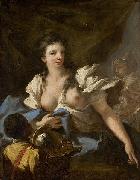 |
Giovanni Antonio Pellegrini -- Click Here
|
|
(29 April 1675 -- November 1741) was a widely-travelled Rococo decorative painter from Venice, where he was born and died. He is considered to be one of the most important Venetian painters of the early 18th century, melding the Renaissance style of Paolo Veronese with the Baroque of Pietro da Cortona and Luca Giordano,and is considered an important predecessor of Giovanni Battista Tiepolo. One of his pupils was Antonio Visentini.
Pellegrini's father, also Antonio, was a shoemaker from Padua. Pellegrini first studied under Girolamo Genga, but was later a pupil of Paolo Pagani and of Sebastiano Ricci. He married Angela Carriera, the sister of Rosalba Carriera, in c.1704. Pellegrini decorated the dome above the staircase at the Scuola Grande di San Rocco in 1709.
He is mainly known for his work in England, which he visited from 1708 to 1713 at the invitation of the Earl of Manchester, and where he had considerable success. He painted murals in a number of English country houses, including Castle Howard (mostly destroyed in 1940) and Kimbolton Castle, Narford Hall, and in London, 31 St James's Square for the Duke of Portland, where George Vertue noted in his notebooks "the hall and Staircase and one or two of the great rooms". He became a director of Sir Godfrey Kneller's Academy in London in 1711. He submitted designs for the decorating the interior dome of the new St Paul's Cathedral, and is said to have been Christopher Wren's favourite painter, but did not win the commission, losing out to Sir James Thornhill.
|
|
 |
Giambattista Pittoni -- Click Here
|
|
(1687?C1767) was an Italian painter of the late-Baroque or Rococo period, active mainly in his native Venice.
Pittoni is best known for his "grand-manner" canvases depicting religious, historical, and mythological subjects (such as Sophonisba and Polyxena). He was a co-founder of the official painter's academy in Venice (in competition to the old fraglia or painter's guild), the Accademia di Belle Arti di Venezia, and he succeeded as President (1758?C1761) his contemporary Giovanni Battista Tiepolo. Pittoni never left his native Venice, but completed commissions from German, Polish, Russian, and Austrian patrons. His mature palette was noted, as was Tiepolo's, for his lightness of tone. Besides Tiepolo, Pittoni's influences were Giovanni Battista Piazzetta, Sebastiano Ricci, and Antonio Balestra. His paintings were of a Rococo style, but later became more sedate in their approach towards Neoclassicism.
|
|
 |
George Price Boyce.RWS -- Click Here
|
|
1826-1897
English painter. He was the son of a prosperous wine merchant and pawnbroker. His childhood was spent in London, and in 1846 he was apprenticed to the firm of architects Wyatt & Brandon, where he remained for three years. He was always fascinated by ancient buildings but gradually lost interest in architecture as a career. In 1849, perhaps as a result of meeting David Cox at Betws-y-Coed (Gwynedd, Wales), he decided to become a painter. In the early 1850s Boyce drew landscape and architectural subjects with a fluent watercolour technique derived from Cox. In 1854 Boyce made an extended journey to Italy; he painted views of buildings in Venice and Verona, which were commended by Ruskin, and semi-abstract twilight studies |
|
 |
George Price Boyce,RWS -- Click Here
|
|
1826-1897
English painter. He was the son of a prosperous wine merchant and pawnbroker. His childhood was spent in London, and in 1846 he was apprenticed to the firm of architects Wyatt & Brandon, where he remained for three years. He was always fascinated by ancient buildings but gradually lost interest in architecture as a career. In 1849, perhaps as a result of meeting David Cox at Betws-y-Coed (Gwynedd, Wales), he decided to become a painter. In the early 1850s Boyce drew landscape and architectural subjects with a fluent watercolour technique derived from Cox. In 1854 Boyce made an extended journey to Italy; he painted views of buildings in Venice and Verona |
|
 |
George Parker Greenwood -- Click Here
|
|
painted White Star Liner Adriatic in 1889 |
|
 |
George P.A.Healy -- Click Here
|
|
American Painter, 1813-1894
American painter, active also in Europe. At the age of 17 he set up a studio in Boston after receiving encouragement from Thomas Sully, who was painting portraits there. Despite his youth and lack of training, he presented himself to the society figure Mrs Harrison Gray Otis and asked if he might paint her portrait (untraced); she agreed and later sponsored Healy's first trip abroad. In 1834 he entered the studio of Antoine-Jean Gros; the French master's suicide the following year ended Healy's only sustained period of artistic study. In Gros's studio he first encountered Thomas Couture, but they did not meet again until the next decade |
|
 |
George John Pinwell,RWS -- Click Here
|
|
1842-1875
English illustrator and painter. He was born in humble circumstances and was largely untrained. He was briefly a student at St Martin's Lane Art School and at Heatherley's. From 1863 he contributed woodblock illustrations to magazines, establishing his reputation in 1865 with the Dalziel brothers' editions of The Arabian Nights and The Works of Oliver Goldsmith. Pinwell's finest drawings were commissioned for the Dalziels' poetry gift-books. With another illustrator, John William North (1842-1924), he worked at Halsway Manor in Somerset in 1865, experimenting with formal effects based on the structure of stone farm buildings or on the wooden beams of barn interiors (his drawings do not seem to have survived). Some of the illustrations for A Round of Days (1866) and Wayside Posies (1867) present an ideal vision of the countryside, but a vein of social concern is also present. In The Journey's End, from Wayside Posies, a strolling player lies dead, worn out by hardship and hunger. For an illustrated edition of Jean Ingelow's Poems (1867), |
|
 |
Georg Pencz -- Click Here
|
|
Georg Pencz (c. 1500 probably in Westheim near Bad Windsheim/Franconia - 1550 in Liepzig) was a German engraver, painter and printmaker.
Pencz travelled to Nuremberg in 1523 and joined Albrecht Dereres atelier. Like Derer, he visited Italy and was profoundly influenced by Venetian art and it is believed he worked with Marcantonio Raimondi. In 1525, he was imprisoned with the brothers Barthel Beham and Hans Sebald Beham, the so-called "godless painters", for spreading the radical views of Thomas Mentzer by asserting disbelief in baptism, Christ and transubstantiation. The three were pardoned shortly afterwards and became part of the group known as the "Little Masters" because of their tiny, intricate and influential prints.
In Nuremberg, influenced by works he had seen in Italy, Pencz painted a number of trompe l'oeil ceilings in the houses of patrician families; one, for which a drawing survives, showed workmen raising building materials on a hoist, against an open sky, to create the illusion that the room was still under construction.
Around 1539, Pencz briefly returned to Italy, visiting Rome for the first time, returning to Nuremberg in 1540, where he became the city painter and earned his greatest success as a portraitist. As an engraver, he ranks among the best of the German eLittle Masterse. Notable prints include Six Triumphs of Petrarch and Life of Christ (26 plates). The best of his paintings are portraits, such as Portrait of a Young Man , Portrait of Marshal Schirmer and Portrait of Erhard Schwetzer and his wife. |
|
 |
georg pauli -- Click Here
|
|
1855-1935, youths bathing, 1914 nationalmuseum |
|
 |
Georg Caspar Prenner -- Click Here
|
|
painted The children of Count Vorontsov in 1755 |
|
 |
Gaspar Peeter Verbrugghen the younger -- Click Here
|
|
Flemish ,
Antwerp 1664-1730
|
|
 |
GARCIA, Pere -- Click Here
|
|
Spanish painter (active 1455-1479 in Barcelona) |
|
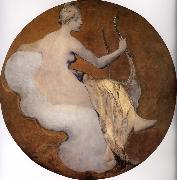 |
Galland Pierre Victor -- Click Here
|
|
Geneve 1822-Paris 1892
He studied metalwork with his father Jacques Galland, an accomplished goldsmith, until age 16. He then entered the studio of Henri Labrouste to study architecture. After two years of training, Labrouste encouraged him to pursue his interest in decorative painting under the direction of Michel-Martin Drolling. In 1843 the decorative painter Pierre-Luc-Charles Ciceri (1782-1868) hired Galland to assist with the painting of figures, flowers, garlands and fruit. He worked again with Labrouste, in 1848, on the decoration of the national festival, the F?te de la Concorde. |
|
 |
Gaetano previati -- Click Here
|
|
Italian Painter, 1852-1920
Italian painter and writer. He was one of the leading exponents of Divisionism, particularly skilled at large-scale decorative schemes, and especially important for his writings on technique and theory. |
|
 |
Gabriel Lory Pere -- Click Here
|
|
Bern 1763-1840 Bern |
|
 |
Fritz Petzholdt -- Click Here
|
|
(1 January 1805 - 29 August 1838) was a Danish landscape painter of the Copenhagen School, also known as the Golden Age of Danish Painting. He spent most of his artistic life in Italy, where he painted refined landscapes in a light colour palette but died early, most likely by way of suicide.
Fritz Petzholdt was born into a prosperous home on 1 January 1805 in Copenhagen to grocer Johan Jacob Petzholdt and his second wife Josephine Marie Elisabeth Petzholdt. After completing an apprenticeship as a house painter, he attended the Royal Danish Academy of Fine Arts from 1824 where he studied under Christoffer Wilhelm Eckersberg, known as the farther of the Golden Age of Danish Painting spanning the first half of the 19th century. He graduated in 1828 and already the following year sold a painting, En mose ved Høsterkøb med tørvearbejdere (A Bog at Høsterkøb), to the Royal Danish Painting Collection.
Although he never won the Academy's gold medal, the traditional opening for Academy students to go abroad to further their studies since it was accompanied by a travel stipend, his family's wealth allowed him to travel to Harz the same year and then, in May 1830, to set out for Rome. On the way he visited Dresden, Prague, Nuremberg, Munich, Venice and Florence. In Rome he joined the Danish artists colony which had formed in the city with Bertel Thorvaldsen as its centre. He made excursions to the Roman countrysideeto places such as Tivoli, Subiaco and Olevanoeas well as longer trips south to Naples, Sicily and Corfu.
In the winter of 1835/36 he returned to Copenhagen due to his farther's illness and subsequent death. Shortly after the funeral, he returned to Italy with an extended stop in Munich on the way. From Italy he continued to Greece, a destination only Martinus Rørbye had visited before him among the Danish Golden Age painters. On 29 August 1838 he was found dead in his hotel room in Patras with his throat cut. Whether it was a case of suicide or murder was never settled.
|
|
 |
Friedrich Paul Nerly -- Click Here
|
|
(Venedig 1842-Luzern 1919 ) - Painter |
|
 |
Frederick richard pickersgill,R.A. -- Click Here
|
|
1820-1900
was an English painter and book illustrator. Born into a family of artists, he was admitted to the Royal Academy Schools in 1840. He did some book illustrations for the works of John Milton and Edgar Allan Poe. Pickersgill's The Burial of Harold was accepted as a decoration for the Houses of Parliament in 1847. He also did some landscapes under the influence of the Pre-Raphaelites. In 1856 Pickersgill was photographed at 'The Photographed Institute' by Robert Howlett, as part of a series of portraits of 'fine artists'. |
|
 |
Franz Pforr -- Click Here
|
|
German
1788-1812
He received his earliest training from his father, the painter Johann Georg Pforr (1745-98), and his uncle, the art professor and first inspector of the painting gallery in Kassel, Johann Heinrich Tischbein the younger (1742-1808). In 1805 he became a student at the Akademie der Bildenden Kenste in Vienna, which was dominated by the severe Neo-classicism of its director, Heinrich Feger; he was taught by Hubert Maurer (1738-1818), Franz Cauzig (1762-1828) and Johann Martin Fischer. During the war with France in 1805, Pforr volunteered as a guard in the Vienna militia. He suffered a nervous breakdown, brought on by the conflict between his passionate longing for a contemplative life and a desire to see military action. He probably turned to religion to help sustain his mental equilibrium. In 1806 he resumed his academic studies and, believing himself destined to become a battle painter, made numerous drawings of historical battles, for example his still schoolish and baroquely composed Wallenstein in the Battle of L?tzen (1806; Frankfurt am Main, Stedel. Kstinst. & St?dt. Gal.). However, it was not until 1807, with Drawing with Twelve Travel Sketches (Frankfurt am Main, Stadt- & Ubib.), that he first began to overcome his beginner style and to develop his own. This resulted in reduced detail, simplified continuous contours, a structuring by means of planar rather than illusionistic criteria, a new clarity of vision and a chastened balance between nature and artistic conception.
|
|
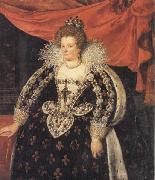 |
Frans Pourbus the younger -- Click Here
|
|
Flemish Baroque Era Painter, 1569-1622
was a Flemish painter, son of Frans Pourbus the Elder and grandson of Pieter Pourbus. He was born in Antwerp and died in Paris. He is also referred to as "Frans II". Pourbus worked for many of the highly influential people of his day, including the Brussels-based Spanish Regents of the Netherlands, the Duke of Mantua and Marie de' Medici, Queen of France. Works of his can be found in the Louvre, the Prado, the Rijksmuseum, the Royal College of Art, the Metropolitan Museum of Art and many other museums. |
|
 |
Frans Pourbus -- Click Here
|
|
Flemish Northern Renaissance Painter, ca.1545-1581
Painter, son of Pieter Pourbus. His work consists mainly of portraits and religious subjects, although he also executed a number of landscapes and history paintings. He worked mostly for the wealthy patrician class, and his work was instrumental in spreading the Romanism of Frans Floris (his teacher) throughout the Netherlands. It is probable that Frans Pourbus's earliest teaching was with his father in Bruges, but by 1564 he is recorded as working in the Antwerp studio of Floris. According to van Mander, Frans Pourbus and his fellow student Crispijn van den Broeck together completed an altarpiece by Floris after the latter's death in 1570. In 1566 Frans Pourbus married Susanna, a daughter of Cornelis Floris and niece of his master, and in 1569/70 he became a master in the Antwerp Guild of St Luke, though he retained his citizenship of Bruges. Gortzius Geldorp was his pupil in Antwerp in 1570. For Ghent Cathedral Frans painted Christ among the Doctors (the Viglius Altarpiece, 1571; in situ), which includes life-size portraits of Emperor Charles V, his son Philip, their secretary Viglius ab Aytta (d 1577), Jansenius, first Bishop of Ghent (d 1576), and the Duke of Alba. A decade later Pourbus executed the portrait of the Hoefnagel Family (c. 1581; Brussels, Mus. A. Anc.), shown grouped around a harpsichord playing musical instruments, in which the artist included a self-portrait (playing a lute) at the upper left. The picture was acquired in 1696 by Constantijn Huygens the younger from a cousin, a Hoefnagel descendant, in exchange for a horse; the young girl of 15 or 16 with a parrot in her hand was Huygens's grandmother. An inventory drawn up after Frans Pourbus death lists 20 portraits by him, many from the circle of the Duke of Anjou. |
|
 |
Frans Post -- Click Here
|
|
1612-1680 Dutch Frans Post Gallery
was a Dutch painter. He was the first European artist to paint landscapes of the New World.
In 1636 he traveled to Dutch Brazil at the invitation of Johan Maurits van Nassau-Siegen, who was governor-general there, at the suggestion of his brother Pieter Post. In 1644, Post returned to Haarlem. Of his Brazilian landscapes, some depict actual locations, while others are probably imaginary. Post's art is usually classified as Baroque. |
|
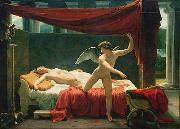 |
Francois-Edouard Picot -- Click Here
|
|
(10 October 1786 - 15 March 1868) was a French painter during the July Monarchy, painting mythological, religious and historical subjects.
|
|
 |
Francois Pascal Simon Gerard -- Click Here
|
|
12 March 1770 - 11 January 1837) was a French painter born in Rome, where his father occupied a post in the house of the French ambassador. His mother was Italian. As a baron of the Empire he is sometimes referred to as Baron Gerard. |
|
 |
Francois Pascal Simon Gerard -- Click Here
|
|
François Pascal Simon, Baron Gerard (12 March 1770 - 11 January 1837) was a French painter born in Rome, where his father occupied a post in the house of the French ambassador. His mother was Italian. As a baron of the Empire he is sometimes referred to as Baron Gerard.
|
|
 |
Francisco Pradilla Ortiz -- Click Here
|
|
(July 24, 1848 - November 1, 1921) was a prolific Spanish painter famous for creating historical scenes.
He was born in Villanueva de Gellego, near Zaragoza in Aragon, and studied initially in Zaragoza and then transferred to the Real Academia de Bellas Artes de San Fernando and the Academia de Acuarelistas in Madrid. In 1873, he won a scholarship to go to Rome. From there he had opportunities to travel to France and Venice and studied the old masters. In 1878 he submitted his painting Doña Joanna of Castile or (Juana la Loca) to the National Exhibition in Spain and was awarded the Medal of Honor. The Spanish Senate then commissioned him to create La Rendicien de Granada (The Surrender of Granada) that took him three years to complete (1882). In 1881 he became the Director of the Spanish Arts Academy in Rome, but resigned from this post after two years. He traveled, mostly in Italy, portraying local themes and people. In 1897 he returned to Madrid as the director of the Museo del Prado. He held this position only briefly and then focused again on painting.
His total output is well over 1,000 paintings showing his interest in a variety of subjects and styles, often without regard of the current fashion. He is primarily recognized for his historical paintings, the last one completed in 1910 carries one of the longer titles of a major painting, Cortejo del bautizo del Prencipe Don Juan, hijo de los Reyes Catelicos, por las calles de Sevilla (Retinue of the Baptism of Don Juan, son of the Catholic Monarchs, Along the Streets of Seville). Much more common, however, are costumbristaseoften romanticized studies that show local customs or mannerseand landscapes that are often sketchy, with impressionistic influences. Financial duress after the bankruptcy of his bank may have imposed a special need to be productive.
He died in Madrid in 1921 at the age of 73.
|
|
 |
Francisco Pedro do Amaral -- Click Here
|
|
Amaral, Francisco Pedro do (1790 - 1831)
painted Portrait of Domitila de Castro Canto e Melo, Marquise of Santos in 19th century
|
|
 |
Francisco Pacheco -- Click Here
|
|
Spanish painter, teacher, and schola
1564-1644, Spanish painter and writer. He is not considered to be a great painter, but he is remembered for his theoretical work Arte de la pintura. The book is the most important contribution to Spanish artistic theory in the 17th century.
|
|
 |
Francis Parsons -- Click Here
|
|
painted Cunne Shote in 1762 |
|
 |
Francesco Primaticcio -- Click Here
|
|
Italian 1504-1570 Francesco Primaticcio Gallery
Born in Bologna, he trained under Giulio Romano in Mantua and became a pupil of Innocenzo da Imola, executing decorations at the Palazzo Te before securing a position in the court of Francis I of France in 1532.
Together with Rosso Fiorentino he was one of the leading artists to work at the Chateau Fontainebleau (where he is grouped with the so-called "First School of Fontainebleau") spending much of his life there. Following Rosso's death in 1540, Primaticcio took control of the artistic direction at Fontainebleau, furnishing the painters and stuccators of his team, such as Nicol?? dell'Abate, with designs. He made cartoons for tapestry-weavers and, like all 16th-century court artists, was called upon to design elaborate ephemeral decorations for masques and f??tes, which survive only in preparatory drawings and, sometimes, engravings. François trusted his eye and sent him back to Italy on buying trips in 1540 and again in 1545. In Rome, part of Primaticcio's commission was to take casts of the best Roman sculptures in the papal collections, some of which were cast in bronze to decorate the parterres at Fontainebleau.[1]
Primaticcio retained his position as court painter to François' heirs, Henri II and François II. His masterpiece, the Salle d'Hercule at Fontainebleau, occupied him and his team from the 1530s to 1559.
Primaticcio's crowded Mannerist compositions and his long-legged canon of beauty influenced French art for the rest of the century.
Primaticcio turned to architecture towards the end of his life, his greatest work being the Valois Chapel at the Abbey of Saint-Denis, although this was not completed until after his death and was destroyed in 1719. |
|
 |
Francesco Peluso -- Click Here
|
|
Italian, 19th century |
|
 |
Francesco Parmigianino -- Click Here
|
|
1503 ~ 1540,Italian painter, draughtsman and printmaker. Beginning a career that was to last only two decades, he moved from precocious success in the shadow of Correggio in Parma to be hailed in the Rome of Clement VII as Raphael reborn. There he executed few large-scale works but was introduced to printmaking. After the Sack of Rome in 1527, he returned to northern Italy, where in his final decade he created some of his most markedly Mannerist works. Equally gifted as a painter of small panels and large-scale frescoes both sacred and profane, he was also one of the most penetrating portrait painters of his age. Throughout his career he was a compulsive draughtsman, not only of preparatory studies for paintings and prints, but also of scenes from everyday life and of erotica. |
|
 |
Francesco Morandini Da Poppi -- Click Here
|
|
Italian Painter (1544-1597) |
|
 |
Francesco di Stefano called Pesellino -- Click Here
|
|
Florence ca 1422-1457 |
|
 |
FOSCHI, Pier Francesco -- Click Here
|
|
Italian painter, Florentine school (b. 1502, Firenze, d. 1567, Firenze)
was an Italian painter active in Florence in a Mannerist style. He was pupil of Andrea del Sarto and assisted Pontormo with his frescoes at Careggi in 1536. He completed 3 altarpieces, commissioned in 1540C1545 for the church of Santo Spirito in Florence: an Immaculate Conception, Resurrection , and a Transfiguration. Foschi was also influenced by and Il Bronzino. One of his pupils was Alessandro Fei. Also called Pier Francesco di Jacopo Foschi or Toschi. He was the son of Pierfrancesco di Jacopo Sandro Foschi, known for his Madonna and Child with the Infant Saint John. (Utah Museum of Fine Arts). Foschi is best noted for his portraits painted between 1530 and 1540, including his Portrait of a Lady (Museo Thyssen-Bornemisza), Portrait of a Young Man Weaving a Wreath of Flowers (Utah Museum of Fine Arts), and his Portrait of a Man, (Uffizi Gallery). In his portraits he adhered to Mannerist style, utilizing a slight Contrapposto in the sitter with their head turned from the body. This pose gave the depiction a spontaneity and sense of movement for the innovative Mannerists, but was eventually so formulaic that it lost its intention of originality. |
|
 |
Follower of Jacopo da Ponte -- Click Here
|
|
painted Christ in the house of Martha and Mary in 16th/17th century
|
|
 |
Filippo Palizzi -- Click Here
|
|
painted Antico corridoio napoletano in 1818 - 1899 |
|
 |
Ferdinand von Piloty -- Click Here
|
|
painted King Ludwig II of Bavaria in generals' uniform and coronation robe in 1865 |
|
|
|
|
| | |
|
|
|
|